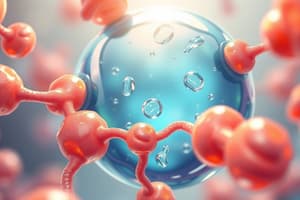Podcast
Questions and Answers
A phospholipid has a 'head' made up of a glycerol molecule attached to a single ___________, which is attached to another small molecule.
A phospholipid has a 'head' made up of a glycerol molecule attached to a single ___________, which is attached to another small molecule.
phosphate group
Because the phosphate group and its attachments are either charged or polar, the phospholipid head is _____, which means it has an affinity for water.
Because the phosphate group and its attachments are either charged or polar, the phospholipid head is _____, which means it has an affinity for water.
hydrophilic
A phospholipid also has two 'tails' made up of two ______________ molecules, which consist of a carboxyl group with a long hydrocarbon chain tail.
A phospholipid also has two 'tails' made up of two ______________ molecules, which consist of a carboxyl group with a long hydrocarbon chain tail.
fatty acid
Because the C-H bonds in the fatty acid tails are relatively nonpolar, the phospholipid tails are __________, which means they are excluded from water.
Because the C-H bonds in the fatty acid tails are relatively nonpolar, the phospholipid tails are __________, which means they are excluded from water.
Answer the following about nonpolar molecules:
Answer the following about nonpolar molecules:
Answer the following about polar molecules:
Answer the following about polar molecules:
Answer the following about ions:
Answer the following about ions:
A red blood cell placed in a hypertonic solution will shrink in a process called crenation. A red blood cell placed in a hypotonic solution will swell and potentially burst in a process called hemolysis. To prevent crenation or hemolysis, a cell must be placed in an isotonic solution such as 0.9% (m/v) NaCl or 5.0% (m/v) glucose. Indicate whether crenation, hemolysis, or neither will occur in the following solutions. Solution A: 3.21% (m/v) NaCl, Solution B: 1.65% (m/v) glucose, Solution C: distilled H2O, Solution D: 6.97% (m/v) glucose, Solution E: 5.0% (m/v) glucose and 0.9% (m/v) NaCl.
A red blood cell placed in a hypertonic solution will shrink in a process called crenation. A red blood cell placed in a hypotonic solution will swell and potentially burst in a process called hemolysis. To prevent crenation or hemolysis, a cell must be placed in an isotonic solution such as 0.9% (m/v) NaCl or 5.0% (m/v) glucose. Indicate whether crenation, hemolysis, or neither will occur in the following solutions. Solution A: 3.21% (m/v) NaCl, Solution B: 1.65% (m/v) glucose, Solution C: distilled H2O, Solution D: 6.97% (m/v) glucose, Solution E: 5.0% (m/v) glucose and 0.9% (m/v) NaCl.
What happens when a cell is in a hypertonic solution?
What happens when a cell is in a hypertonic solution?
What happens when a cell is in a hypotonic solution?
What happens when a cell is in a hypotonic solution?
What happens when a cell is in an isotonic solution?
What happens when a cell is in an isotonic solution?
What name is given to the process by which water crosses a selectively permeable membrane?
What name is given to the process by which water crosses a selectively permeable membrane?
If a red blood cell is placed in a salt solution and bursts, what is the tonicity of the solution relative to the interior of the cell?
If a red blood cell is placed in a salt solution and bursts, what is the tonicity of the solution relative to the interior of the cell?
The water-soluble portion of a phospholipid is the polar head, which generally consists of a glycerol molecule linked to a phosphate group.
The water-soluble portion of a phospholipid is the polar head, which generally consists of a glycerol molecule linked to a phosphate group.
Which of the following particles could diffuse easily through a cell membrane?
Which of the following particles could diffuse easily through a cell membrane?
What property of dishwashing liquid (detergent) makes it useful to wash grease from pans?
What property of dishwashing liquid (detergent) makes it useful to wash grease from pans?
Osmosis is a type of diffusion.
Osmosis is a type of diffusion.
How can a lipid be distinguished from a sugar?
How can a lipid be distinguished from a sugar?
What factors affect the membrane permeability?
What factors affect the membrane permeability?
Molecules always move independently from other types of molecules when passing through a membrane.
Molecules always move independently from other types of molecules when passing through a membrane.
When do concentration gradients exist that drive diffusion of two different types of molecules?
When do concentration gradients exist that drive diffusion of two different types of molecules?
When is there a net movement of particles from one side of the membrane to the other?
When is there a net movement of particles from one side of the membrane to the other?
Will one type of particle only move from one side to the other?
Will one type of particle only move from one side to the other?
When is there no net movement of particles?
When is there no net movement of particles?
Which of the following molecules can cross the lipid bilayer of a membrane easily, without a transport protein or other mechanism? Select all that apply.
Which of the following molecules can cross the lipid bilayer of a membrane easily, without a transport protein or other mechanism? Select all that apply.
When talking about protein channels and carriers, Only Channels:
When talking about protein channels and carriers, Only Channels:
When talking about protein channels and carriers, Only Carriers:
When talking about protein channels and carriers, Only Carriers:
When talking about protein channels and carriers, Both Channels and Carriers:
When talking about protein channels and carriers, Both Channels and Carriers:
When talking about endocytosis and exocytosis, Only exocytosis:
When talking about endocytosis and exocytosis, Only exocytosis:
When talking about endocytosis and exocytosis, Only endocytosis:
When talking about endocytosis and exocytosis, Only endocytosis:
When talking about endocytosis and exocytosis, Both exocytosis and endocytosis:
When talking about endocytosis and exocytosis, Both exocytosis and endocytosis:
Endocytosis moves materials _____ a cell via _____.
Endocytosis moves materials _____ a cell via _____.
A white blood cell engulfing a bacterium is an example of _____.
A white blood cell engulfing a bacterium is an example of _____.
Flashcards are hidden until you start studying
Study Notes
Phospholipids
- Composed of a glycerol "head" linked to a phosphate group, which is charged or polar and hydrophilic.
- Two "tails" consist of fatty acid molecules with long hydrocarbon chains, making them hydrophobic and excluded from water.
Molecular Properties
- Non-polar molecules are hydrophobic, easily crossing lipid bilayers without transport proteins.
- Polar molecules are hydrophilic, struggle to cross lipid bilayers, and require transport proteins for efficient passage.
- Ions are also hydrophilic, facing similar challenges as polar molecules when crossing membranes.
Tonicity and Cell Behavior
- Hypertonic solutions cause red blood cells to shrink (crenation) due to water loss.
- Hypotonic solutions result in swelling and potential bursting of cells (hemolysis).
- Isotonic solutions maintain cell integrity with no net water movement; solutions like 0.9% NaCl or 5% glucose exert equal osmotic pressure as the cell interior.
Water Movement
- Osmosis is the process by which water crosses selectively permeable membranes.
- A red blood cell in a salt solution that bursts is in a hypotonic environment.
Membrane Permeability Factors
- Factors influencing membrane permeability include temperature, saturation of hydrocarbon tails, and cholesterol levels in the membrane.
- Lipids are mostly non-polar, whereas sugars are polar, serving as key differentiators between these two classes of biomolecules.
Diffusion and Equilibrium
- Concentration gradients exist pre-equilibrium, driving the diffusion of different types of molecules.
- There is net particle movement from one side of the membrane to another only before equilibrium is reached.
- No net movement of particles occurs at equilibrium, with independent movement of different molecules.
Protein Transport Mechanisms
- Channels provide continuous pathways for small ions and water to cross membranes quickly.
- Carriers change shape to transport small polar organic molecules across the membrane.
- Both channels and carriers offer hydrophilic pathways, serve as integral membrane proteins, and facilitate transport down gradients.
Endocytosis and Exocytosis
- Exocytosis secretes large molecules out of cells, increases plasma membrane surface area, and involves vesicle fusion with the membrane.
- Endocytosis decreases plasma membrane surface area and creates vesicles through inward folding.
- Both processes require energy and do not involve the physical crossing of substances through the plasma membrane.
Special Cases
- Endocytosis can bring materials into cells via membranous vesicles.
- An example of phagocytosis is a white blood cell engulfing a bacterium.
Studying That Suits You
Use AI to generate personalized quizzes and flashcards to suit your learning preferences.




